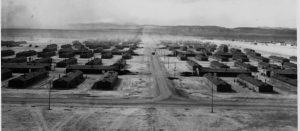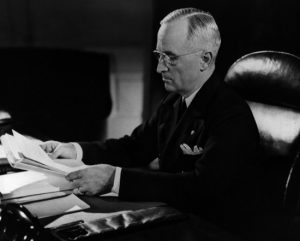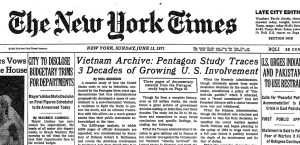
The Topaz War Relocation Center, where Fred Korematsu was sent after his arrest (National Archives)

The Topaz War Relocation Center, where Fred Korematsu was sent after his arrest (National Archives)

President Harry S. Truman (United States Army Signal Corps, Harry S. Truman Library & Museum.)
On Wednesday, April 25th, the Supreme Court will hear arguments in Trump v. Hawaii. The case stems from a presidential executive order that bans people from six countries*, five of which are Muslim-majority, from entering the United States. The White House issued the ban arguing that travelers from Iran, Syria, Libya, Yemen, Somalia and North Korea could pose a security risk, despite the fact that no citizen from these countries has carried out a fatal terrorist attack in the U.S. in the past two decades. The Court will hear arguments as to whether the President overstepped the limits of the Executive branch by issuing immigration orders that contradict earlier ones issued by Congress.
Trump v. Hawaii could be the greatest test of presidential authority in 66 years. In 1952, in a case called Youngstown v. Sawyer, the Court overturned an order by President Harry Truman that seized control of the U.S. steel industry during the Korean War to prevent it from being disrupted by a labor strike. In a 6-3 opinion, the Court ruled that President Truman violated the Separation of Powers laid out in the Constitution by seizing the industry without Congressional approval. The president cannot give himself that authority, the Court ruled, because “[i]n the framework of our Constitution, the President’s power to see that the laws are faithfully executed refutes the idea that he is to be a lawmaker.”
Learn more about the limits of Presidential Power in our film about Youngstown v. Sawyer, Checks and Balances.
*The Executive Order, signed on September 24, 2017, followed two previous E.O.s issued in January and March 2017 that were rescinded following legal challenges. The September E.O. initially included a sixth Muslim-majority country, Chad, but the White House removed Chad from the list earlier this month.

46 years ago today, the first of what would become known as the Pentagon Papers were published by The New York Times. The papers were a classified report that contained damning evidence that the administration of President Lyndon Johnson had been lying to the public and Congress about the Vietnam War, and that the administration had secretly expanded the size of the war to include surrounding countries. The report was leaked by one of its authors, Daniel Ellsberg. President Richard Nixon, Johnson’s successor, sued The Times to prevent further publication of the papers, so The Washington Post and other publications printed them instead.
On June 30, 1971, the Supreme Court ruled 6-3 in New York Times Co. v. United States that the White House had failed to show proper cause to prevent the publication of the Pentagon Papers and that The New York Times was protected by the First Amendment’s guarantee of Freedom of the Press. In his concurring opinion, Justice Hugo Black wrote of the essential role the press plays in our democracy. “In the First Amendment, Black wrote, “the Founding Fathers gave the free press the protection it must have to fulfill its essential role in our democracy. The press was to serve the governed, not the governors. The Government’s power to censor the press was abolished so that the press would remain forever free to censure the Government. The press was protected so that it could bare the secrets of government and inform the people. Only a free and unrestrained press can effectively expose deception in government.”
Learn more about the Pentagon Papers in our film Freedom of the Press: New York Times v. United States.